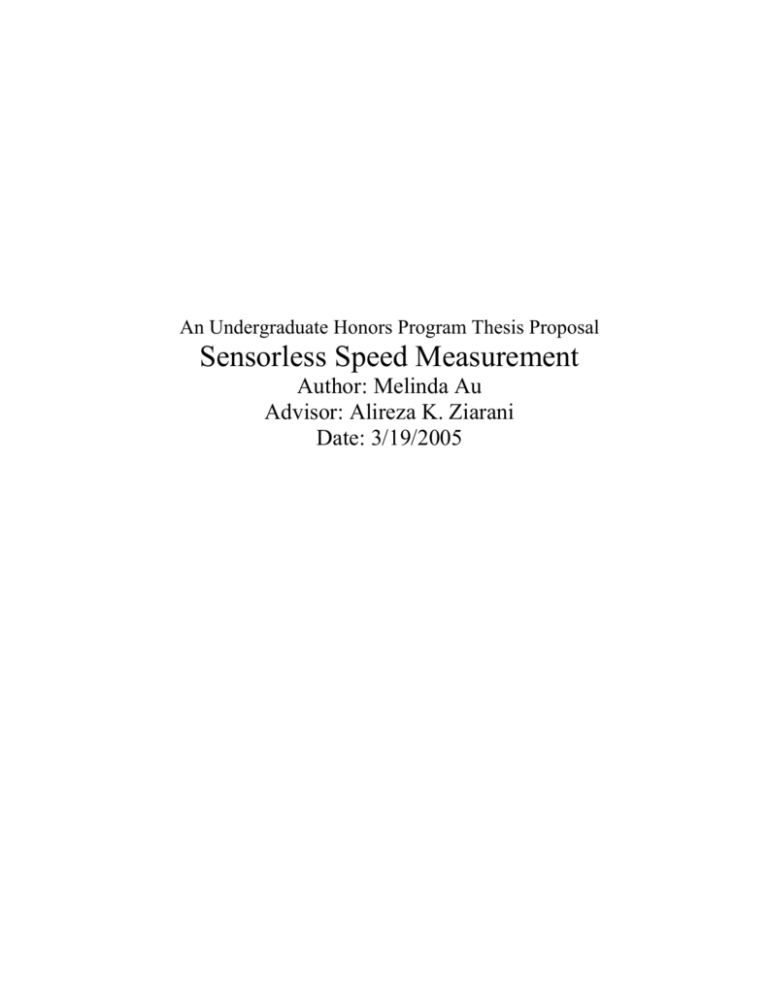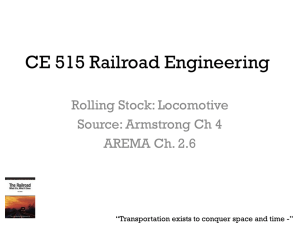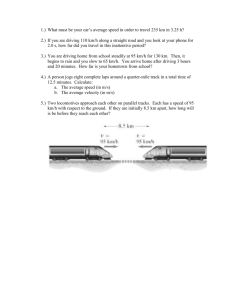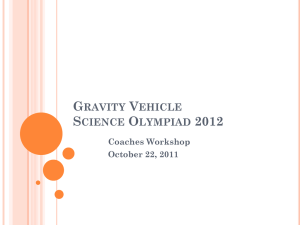An Undergraduate Honor`s Program Thesis Proposal
advertisement

An Undergraduate Honors Program Thesis Proposal Sensorless Speed Measurement Author: Melinda Au Advisor: Alireza K. Ziarani Date: 3/19/2005 Table of Contents: 1. 2. 3. 4. 5. 6. Objective ..................................................................................................................... 3 Purpose........................................................................................................................ 3 Background ................................................................................................................. 4 Proposed Work............................................................................................................ 7 Time Line .................................................................................................................... 7 Summary ..................................................................................................................... 7 Table of Figures: Figure 1: System Input/Output Diagram............................................................................. 5 Figure 2: Block Diagram of System ................................................................................... 6 Table of Equations: Equation 1: Input/Output Equations ................................................................................... 5 Equation 2: Cost Function .................................................................................................. 5 Equation 3: Gradient Decent Method ................................................................................. 5 Equation 4: Differential Equations Obtained from Gradient Decent Method .................... 6 1. Objective To implement a sensorless speed measurement technique that works on any of GE Transportation - Rail’s traction motors contained within their AC locomotives, using a phaselocked loop (PLL), with the main focus being locked axle detection. 2. Purpose General Electric Transportation - Rail (GETR) is a leading global supplier to the railroad industry. Because of this, GETR needs to produce safe and reliable products. There are monitoring systems on board the cab of every locomotive that informs the driver of the status of the locomotive. One component being monitored is the speed of the GE AC traction motor [1]. It is important to know the speed of the traction motor because it drives the axles and in turn the propulsion of the locomotive. It is possible for one or more of the axles to stop from moving while the locomotive is still in motion. This refers to when an axle is locked. If the axle is not fixed and the locomotive continues to move then there is a possibility for the locomotive to derail itself. This being stated it is vital to have accurate and fast responding locked axle detection. The current system in place for axle lock detection is a mechanical speed sensor. Sensors are mounted underneath the locomotive next to each axle. The sensors monitor the axles’ speed as well as notifying if an axle becomes locked [2]; however, the environment underneath a locomotive is polluted with heat and vibrations. The vibrations can cause the thin cables connected to the sensor to fall out and the heat can actually ruin the sensor itself. If either two scenarios occur or anything else to disrupt the sensor the axle is logged as being locked causing the locomotive to stop and also forcing voltage to be removed from the rail. This can be a big process and cost a rail company lots of time and money, not to mention when a sensor breaks it has to be replaced adding to the cost. This is where the use of sensorless speed measurement can be more reliable and cost efficient. There are many different methods for sensorless speed measurement. A few of the proposed techniques are an adaptive method, an analytic wavelet transformation and a phase-locked loop. The adaptive method takes into consideration that speed changes slowly when compared to electrical variables and uses speed as the unknown variable [3]. It then uses the derivates of the flux to estimate the speed. The algorithm however is sensitive to its parameter variations and has issues working under full load torque. Next analytic wavelet transformation utilizes the current harmonics and is similar to Fourier-related transforms where it can be implemented in real time. It can also be applied over the entire speed range and is faster then most techniques [4]. However, for the axles on GE AC locomotives, taking a simple measurement of either the back emf or the current harmonics one can obtain an AC signal that corresponds to the speed of the motor. The signal from the motor however will be distorted with noise from the surrounding environment making it hard to use, but if one can reconstruct the signal through the noise then they can use the frequency of the signal to determine the speed of the motor. The use of a phaselocked loop (PLL) can serve this purpose very well. A PLL is driven by an oscillator that continuously adjusts to lock onto the frequency of its input signal. Thus it can reconstruct the signal with less noise. Noise immunity is one reason why the PLL is a good method but it also can be implemented in hardware or software making it very useful for the application to GE’s AC locomotives. For the purposes of this research Professor Alireza K. Ziarani’s algorithm is chosen as our sensorless speed measurement technique. Implementing Professor Ziarani’s algorithm as a digital PLL can establish the unknown frequency of the input signal in order to determine the speed of the traction motor and ultimately remove the mechanical sensors on GE’s AC locomotives [5]. Other existing methods that could possibly serve the purpose of Professor Ziarani’s algorithm are the Kalman Filter and the filter of Regalia et al. Kalman filtering is an algorithm which makes optimal use of inaccurate data on a linear system with Gaussian errors to continuously update the best estimate of the system's current state. While, the filter of Regalia et al. is essentially a second order notch filter to which an adaptation mechanism is augmented [6]. However, when compared with both methods Professor Ziarani’s algorithm is more fit for this practical application because of its high degree of noise immunity, its ability to provide a direct estimate of the amplitude and phase of the extracted sinusoid, and the wide variation of parameters allowed within the settings of the system [7]. Professor Ziarani is also a specialist in nonadaptive signal processing and resides at Clarkson University making him a very knowledgeable resource in this research. This paper will take a look at the system behind Professor Ziarani’s algorithm and its practical application to locked axle detection on GE’s AC locomotives. It will be concluded with a timeline for research. 3. Background The following section gives a simplified overview of Professor Ziarani’s algorithm. For further in-depth understanding please refer to the endnotes attached to this paper. Due to the nature of this research the input signal to this algorithm has a very large frequency variation. The traction motor is constantly changing speeds and thus ranging the frequency of the back AC emf signal. Ziarani has developed a special system with his algorithm that takes into account this high variation and again makes the algorithm fit for this research. The system assumes a voltage or current signal as the input u(t) which is usually continuous and almost periodic. It also contains all the undesired characteristics as well. The output of the system y(t) is equal to a sinusoidal signal with amplitude A(t) and frequency (t ) d (t ) which t represents the total phase [7]. ωo (not essential) u(t) System y(t) = A(t)sin(∫ωdτ +δ(t)) A(t) Φ(t) ω(t) Figure 1: System Input/Output Diagram u (t ) uo (t ) u1 (t ) in which uo (t ) Ao sin( ot o ) Equation 1: Input/Output Equations At any point in time we can extract the amplitude, constant phase and frequency from the system, where y(t) is an estimate of uo(t) and u1(t) is the undesired components of the signal. This leads us to the least squared error between the original signal without the interference and the estimated signal. To minimize y(t) Professor Ziarani chooses the method of gradient decent. This method defines a cost function as 1 1 J (t , ) [u (t ) y (t , )]2 e 2 (t , ) 2 2 Equation 2: Cost Function Here θ is the vector of parameters that define the sinusoidal output. Theta is continuously adjusted so that J approaches its minimum point. Ziarani then defines a matrix of μ of real positive constants that allows him to rewrite the gradient decent method as (t ) J (t , ) Equation 3: Gradient Decent Method Using this method achieves the minimization process desired yet it only works if the cost function is globally in quadratic parameters [8]. However, as with Professor Ziarani’s system the parameters are not quadratic. To allow him to use this method he derives a mathematical proof to guarantee the convergence of the solutions of the gradient decent method to the minimum point of the cost function [7]. After following the gradient decent method the following differential equations are obtained A(t ) 21e(t ) sin (t ) (t ) 2 2 e(t ) A(t ) cos (t ) (t ) w(t ) 3 w(t ) Equation 4: Differential Equations Obtained from Gradient Decent Method The values for the coefficients determined heuristically, but there are a few general rules to when selecting them. The first coefficient, 1, is what controls the amplitude of the estimated signal. The larger it is the faster it tracks the amplitude. Meanwhile, 2 and 3 jointly determine the phase and frequency of the output signal. The larger 2 the faster the tracking of the phase occurs. Another distinct rule is that 2·3 has the same order of magnitude as 1. For this research we will start out with the values for 1, 2 and 3 as 10, 500, and .08 respectively. Then upon testing the values will be adjusted to meet the needs of the PLL with the given input signal. Using the equations above and the output equation y(t) and the equation for e(t) we have the system for the PLL. Translating these equations into a block diagram we can see what is going on and also how to implement it into programs such as Matlab. u(t) + e(t) 2µ 1 A x - x y(t) Sin 2µ 2 x + + Cos µ3 Figure 2: Block Diagram of System By taking the output y(t) from our algorithm we can record the frequency of the changing signal. From the frequency we can determine the speed of the motor in rpms. Frequency is measured in Hertz which is the same as cycles per second so to get RPM or revolutions per minutes you just simply multiply the frequency by a factor of 60 to convert it to RPMs. 4. Proposed Work Using General Electric Transportation – Rail’s facilities located in Erie, PA, the first step is to collect the data from the noisy AC input signal of the various axles underneath the locomotive. This will be done on both the locomotives ran on the test tract and on the traction motors isolated in a testing facility. Using inverter software [9 and one axle at a time, the data can be imported into Microsoft Excel. Various locomotives will be tested as well as different axles on the locomotives. The traction motor will be run at a known speed (rpm) and the raw data will be recorded. After all the data has been recorded time domain plots as well as frequency plots will be done. These plots will allow the noisy signal to be viewed and analyzed. While gathering data the algorithm will have to be specifically designed to handle the AC signal from the axles, in other words the values of the coefficients will have to be fined tuned. Once data has been collected from various AC locomotives and their different axles, the algorithm will be run on the raw data. The results of the algorithm will be plotted using Matlab and the frequency of the output signal will be measured and recorded. Again both time and frequency domain plots will be done to give a detailed view of how the algorithm worked. Then by converting the frequencies of the output signal of the algorithm of the various samples of data, an error analysis will done between the estimated speed from the algorithm to the actual speed the motor was ran at. Lastly, if the PLL works accurately and consistently maybe circuitry hardware or software can be designed and implemented in place of the mechanical sensor. 5. Time Line Event Date Submit Proposal to GE Legal Operations 3/20/2005 Begin Testing 3/23/2005 End Testing 8/5/2005 Submit Final Thesis 12/12/2005 6. Summary A sensorless speed measurement technique for locked axle detection on GE’s AC locomotives is presented. The technique is a digital PLL that establishes the unknown frequency of the input signal in order to determine the speed of the traction motor. This PLL is modeled after Professor A. K. Ziarani’s algorithm that extracts nonstationary sinusoids. The current speed sensors on the locomotives are unreliable due to the harsh conditions underneath the locomotives. The PLL can over come those conditions and either through software or hardware be implemented on the locomotive in place of the sensor. The PLL will be tested to track the corrupted AC back emf signal of the axles and if it outputs a clean version of the signal with accurate frequency. Then the frequency of the output signal will be used to determine the speed of the motor or if there is a locked axle and compared to the existing technique. References [1] URL: https://www.getransportation.com/homepage/index.asp [2] General Electric Transportation – Rail. Union Pacific po# 1982 Road Numbers: 5354-5553 (UP27) 84X275214LAG5 (30). Jan 14 2005. BW Publicover, Erie, Pennsylvania. [3] Shauder, C., Adaptive speed identification scheme for vector control of induction motors without rotational transducers. IEEE Trans. On Industry Applications, vol. 28, no. 5, pp. 10541061, September/October 1992. [4] Aller, J.M.; Habetler, T.G.; Harley, R.G.; Tallam, R.M., Sensorless speed measurement of AC machines using analytic wavelet transform. Sang Bin Lee, Industry Applications, IEEE Transactions on Volume 38, Issue 5, Sept.-Oct. 2002 Page(s):1344 - 1350 [5] A.K. Ziarani, and M. Karimi-Ghartemani, Performance characterization of a non-linear system as both an adaptive notch filter and a phased-locked loop. Int. J. Adapt. Control Signal Process. 2004; 18:23-53 (DOI: 10.1002/acs.780) [6] P. Regalia, An improved lattice-based adaptive IIR notch filter, IEEE Trans. Signal Process. 39 (September 1991) 2124-2128. [7] A.K. Ziarani, and A. Konrad, A method of extraction of nonstationary sinusoids. Signal Processing 84 (2004) 1323-1346 [8] Handel P, Nehorai A. Tracking analysis of an adaptive notch filter with constrained poles and zeros. IEEE Transactions on Signal Processing 1994; 42(2):281-291 [9] General Electric Transportation – Rail, Electronic Inverter Prime PM 5136. MI11314-002, GEK 76432. Erie, Pennsylvania.







